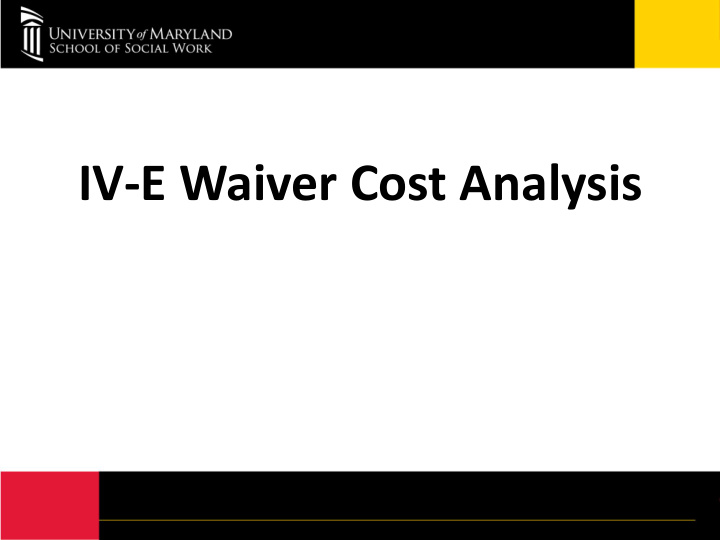



IV-E Waiver Cost Analysis
#1 - How are IV-E Waiver dollars being spent? • Goals: To track the money being allocated to each county by funding steam (e.g., EBPs vs. Family Support), to describe the goods and services provided, and to indicate the # of clients served • How? The Evaluation Team is working with DHR to develop a detailed spreadsheet that will be completed on a regular basis by each of the 24 Maryland jurisdictions.
#2 - How have DHR’s costs shifted with the implementation of the Waiver? • Goal: To determine whether the flexibility afforded to DHR by the Waiver has resulted in reduced administrative costs and to evaluate whether out-of-home costs decline during the Demonstration period • How? The Evaluation Team will work with DHR to identify and track major funding sources (e.g., Title IV-E, TANF, Title IV-B, etc.) used to pay for child welfare activities and to further break down each funding source into its cost components (e.g., administration and maintenance, training). Trends over time will be examined.
#3 – What is the net benefit/cost of implementing EBPs under the IV-Waiver? • Goal: To determine whether the costs associated with EBPs are offset by their associated benefits, such as reduced costs associated with out-of-home placements • How? Program costs related to personnel, facilities (e.g., rent), supplies, etc. will be collected from EBP providers on a semi- annual basis. For up to three EBPs, cost-benefit analyses will be conducted, with non-EBP youth in the same county serving as comparisons. Costs associated with non-EBP placements will be obtained from DHR.
#4 – How does implementation of EBPs affect Medicaid costs? • Goals: To assess 1) whether MA claims for were reduced for youth following their participation in EBPs, and 2) whether MA claims for EBP participants are lower than those placed in out-of-home care. • How? Analyses will depend on the full implementation of EBPs and the availability of Medicaid claims data. Analyses will be conducted in future evaluation years.
Maryland State-wide Indicators State Fiscal Years 2013-16
State-wide Indicators Throughout the Waiver implementation, several state- level indicators will be monitored to assess any changes from historical trends prior to the Waiver and during Waiver implementation The following presents rates of reunification, adoption, and guardianship; placement stability; length of stay of removal; response track; and residential placements from SFY’s 2013 -15 (pre-Waiver) and 2016 (first year of Waiver implementation)
Response Track Pre-Waiver Waiver 100% 80% 60% Alternative Response 40% Investigative 20% Response 0% SFY 13 SFY 14 SFY 15 SFY 16 (N=40,595) (N=36,034) (N=31,944) (N=30,817)
Other Statewide Indicators Placement Stability Rates of Reunification, Adoption, & Guardianship 8.0 Waiver Pre-Waiver 100% Exits from OOHP 7.0 Pre-Waiver Waiver 80% 6.0 4.6 4.5 4.2 4.2 5.0 60% 4.0 40% 3.0 2.0 20% 1.0 0% 0.0 SFY 13 SFY 14 SFY 15 SFY 16 FY13 FY14 FY15 FY16 (N=3,218) (N=3,016) (N=2,633) (N=2,486) (N=2,532) (N=2,401) (N=2,185) (N=2,480) Reunification Adoption Guardianship Moves per 1,000 Days in Care Length of Stay of Removals Residential Placements 10% 250 Pre-Waiver Waiver Pre-Waiver Waiver 8% 200 6.5% 6.2% 136 132 130 5.6% 128 Entrie 6% 150 4.4% 4% 100 1.9% 1.8% 1.5% 1.3% 2% 50 0% 0 FY13 FY14 FY15 FY16 FY13 FY14 FY15 FY16 (N=2,533) (N=2,421) (N=2,195) (N=2,491) (N=2,532) (N=2,401) (N=2,185) (N=2,480) Average Days Removed Community Residential Non-Community Residential
How to Contact Us: Elizabeth Greeno, PhD Pam Freeman, PhD Sara Betsinger, PhD Bethany Lee, PhD Lead Evaluator for Lead Evaluator for EBPs Lead Cost Evaluator Evaluation Director CANS-F/ Trauma sbetsinger@ssw.umaryland.edu egreeno@ssw.umaryland.edu blee@ssw.umaryland.edu pfreeman@ssw.umaryland.edu David Chen John Cosgrove Rochon Steward Maria Jose Horen Senior Data Analyst Senior Data Analyst Research Specialist Research Supervisor dchen@ssw.umaryland.edu jcosgrove@ssw.umaryland.edu rsteward@ssw.umaryland.edu mjhoren@ssw.umaryland.edu
Recommend
More recommend